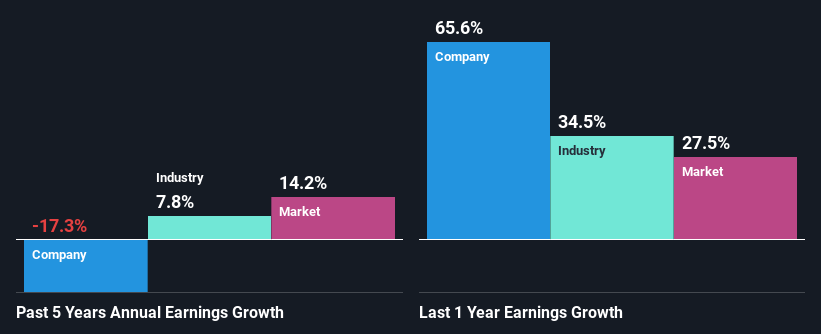Eastman Chemical Company's (NYSE:EMN) Stock Has Shown Weakness Lately But Financial Prospects Look Decent: Is The Market Wrong?
It is hard to get excited after looking at Eastman Chemical's (NYSE:EMN) recent performance, when its stock has declined 15% over the past three months. However, the company's fundamentals look pretty decent, and long-term financials are usually aligned with future market price movements. Particularly, we will be paying attention to Eastman Chemical's ROE today.
Return on equity or ROE is a key measure used to assess how efficiently a company's management is utilizing the company's capital. In other words, it is a profitability ratio which measures the rate of return on the capital provided by the company's shareholders.
View our latest analysis for Eastman Chemical
How Is ROE Calculated?
ROE can be calculated by using the formula:
Return on Equity = Net Profit (from continuing operations) ÷ Shareholders' Equity
So, based on the above formula, the ROE for Eastman Chemical is:
14% = US$826m ÷ US$6.0b (Based on the trailing twelve months to March 2022).
The 'return' is the yearly profit. That means that for every $1 worth of shareholders' equity, the company generated $0.14 in profit.
Why Is ROE Important For Earnings Growth?
Thus far, we have learned that ROE measures how efficiently a company is generating its profits. We now need to evaluate how much profit the company reinvests or "retains" for future growth which then gives us an idea about the growth potential of the company. Generally speaking, other things being equal, firms with a high return on equity and profit retention, have a higher growth rate than firms that don’t share these attributes.
Eastman Chemical's Earnings Growth And 14% ROE
To begin with, Eastman Chemical seems to have a respectable ROE. Further, the company's ROE is similar to the industry average of 17%. For this reason, Eastman Chemical's five year net income decline of 17% raises the question as to why the decent ROE didn't translate into growth. So, there might be some other aspects that could explain this. Such as, the company pays out a huge portion of its earnings as dividends, or is faced with competitive pressures.
However, when we compared Eastman Chemical's growth with the industry we found that while the company's earnings have been shrinking, the industry has seen an earnings growth of 7.8% in the same period. This is quite worrisome.
Earnings growth is an important metric to consider when valuing a stock. The investor should try to establish if the expected growth or decline in earnings, whichever the case may be, is priced in. Doing so will help them establish if the stock's future looks promising or ominous. What is EMN worth today? The intrinsic value infographic in our free research report helps visualize whether EMN is currently mispriced by the market.
Is Eastman Chemical Making Efficient Use Of Its Profits?
Looking at its three-year median payout ratio of 47% (or a retention ratio of 53%) which is pretty normal, Eastman Chemical's declining earnings is rather baffling as one would expect to see a fair bit of growth when a company is retaining a good portion of its profits. It looks like there might be some other reasons to explain the lack in that respect. For example, the business could be in decline.
Moreover, Eastman Chemical has been paying dividends for at least ten years or more suggesting that management must have perceived that the shareholders prefer dividends over earnings growth. Existing analyst estimates suggest that the company's future payout ratio is expected to drop to 28% over the next three years. The fact that the company's ROE is expected to rise to 23% over the same period is explained by the drop in the payout ratio.
Conclusion
On the whole, we do feel that Eastman Chemical has some positive attributes. Yet, the low earnings growth is a bit concerning, especially given that the company has a high rate of return and is reinvesting ma huge portion of its profits. By the looks of it, there could be some other factors, not necessarily in control of the business, that's preventing growth. With that said, we studied the latest analyst forecasts and found that while the company has shrunk its earnings in the past, analysts expect its earnings to grow in the future. To know more about the company's future earnings growth forecasts take a look at this free report on analyst forecasts for the company to find out more.
Have feedback on this article? Concerned about the content? Get in touch with us directly. Alternatively, email editorial-team (at) simplywallst.com.
This article by Simply Wall St is general in nature. We provide commentary based on historical data and analyst forecasts only using an unbiased methodology and our articles are not intended to be financial advice. It does not constitute a recommendation to buy or sell any stock, and does not take account of your objectives, or your financial situation. We aim to bring you long-term focused analysis driven by fundamental data. Note that our analysis may not factor in the latest price-sensitive company announcements or qualitative material. Simply Wall St has no position in any stocks mentioned.

 Yahoo Finance
Yahoo Finance 
